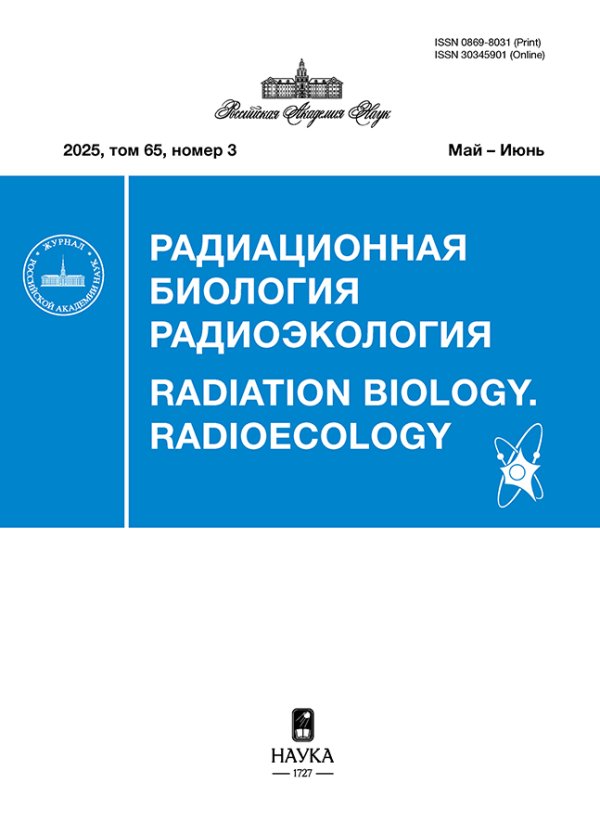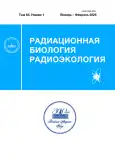THE DYNAMICSOF THE DOSEOF EXTERNAL γ-RADIATIONIN PINESTANDSIN THE BELARUSIANSECTOROF THE 30-KILOMETERZONEAROUNDTHE CHERNOBYLNUCLEAR POWERPLANT
- Authors: Perevolotskaya T.V.1, Perevolotsky A.N.1, Geras’kin S.A.1
-
Affiliations:
- Russian Institute of Radiology and Agroecology of National Research Centre “Kurchatov Institute”
- Issue: Vol 65, No 1 (2025)
- Pages: 102-112
- Section: Radioecology
- URL: https://bakhtiniada.ru/0869-8031/article/view/308036
- DOI: https://doi.org/10.31857/S0869803125010097
- EDN: https://elibrary.ru/kpazcj
- ID: 308036
Cite item
Abstract
The external γ-radiation in an area contaminated by accidental radioactive fallout changes due to the radioactive decay of radionuclides and their migration in the vertical profile of the soil. The purpose of the research was to evaluate the quantitative parameters of the dynamics of the dose rate of external γ-radiation in the pine plantations of the Belarusian sector of the 30-kilometer zone around the Chernobyl nuclear power plant. Dose rate measurements were carried out at experimental objects from 1987 to 2023. It was shown that at the most polluted experimental facility in the Kr, it decreased from 47 in 1987 to 4.5mGy/hin the early 20s, and at the Ms facility from 35 to 1.8mGy/h, respectively. The dynamics of dose rate was approximated by a two-exponential relationship. The first term of the dependence determined the “rapid” changes in the dose index from 1987 to the mid-90s with a half-decrease period of 0.8–1.6 years and is associated with the radioactive decay of medium-lived radionuclides. The second term determined the “slow” dose rate changes since the mid-90s with a half-decrease period of 10–16 years and is due to the radioactive decay of 137Cs and its redistribution in the surface soil layers. The contribution of “rapid” changes to the dose rate reduction over the entire study period ranged from 55 to 77% and was directly dependent on the partial contribution to the total radioactive contamination of medium-lived radionuclides (144Ce and 106Ru). The estimated accumulated dose of external radiation in the air-plant environment of the experimental facilities of the Kr and Ms can currently reach 2 and 4 Gy. For this reason, it is necessary to conduct further studies to assess the effects of the habitat of a radiosensitive reference organism, pine trees, under conditions of prolonged radiation exposure.
About the authors
T. V. Perevolotskaya
Russian Institute of Radiology and Agroecology of National Research Centre “Kurchatov Institute”
Author for correspondence.
Email: forest_rad@mail.ru
Obninsk, Russia
A. N. Perevolotsky
Russian Institute of Radiology and Agroecology of National Research Centre “Kurchatov Institute”
Email: Aleks_Perevolotsky@mail.ru
Obninsk, Russia
S. A. Geras’kin
Russian Institute of Radiology and Agroecology of National Research Centre “Kurchatov Institute”
Email: stgeraskin@gmail.com
Obninsk, Russia
References
- ICRP Publication 136. Dose Coefficients for Non-human Biota Environmentally Exposed to Radiation. Ann. ICRP 46 (2). London: SGSE Publications Ltd., 2017. 136 p. https://doi.org/10.1177/0146645317728022
- Ulanovsky A. Dosimetry for animals and plants: contending with biota diversity. Annals of the ICRP. Proceedings of the Third International Symposium on the System of Radiological Protection. Viena: SAGE Publications. 2016;45(1): 225–238, 2016. https://doi.org/10.1177/0146645316630710
- Hashimoto S., Komatsu M., Miura S. Forest Radioecology in Fukushima: Radiocesium Dynamics, Impact and Future. Springer Nature Singapore Pte Ltd., 2022. 160 p. https://doi.org/10.1007/978-981-16-9404-2
- Radiocesium Dynamics in a Japanese Forest Ecosystem. Initial Stage of Contamination After the Incident at Fukushima Daiichi Nuclear Power Plant. Eds. C. Takenaka, N. Hijii, N. Kaneko, T. Ohkubo. Springer Nature Singapore Pte Ltd., 2019. 234 p. https://doi.org/10.1007/978-981-13-8606-0
- Sanada Y., Urabe Y., Sasaki M. et al. Evaluation of ecological half-life of dose rate based on airborne radiation monitoring following the Fukushima Dai-ichi nuclear power plant accident.J. Environ. Radioact.2018;192:417–425. https://doi.org/10.1016/j.jenvrad.2018.07.016
- Saito K., Mikami S., Andoh M. et al. Summary of temporal changes in air dose rates and radionuclide deposition densities in the 80 km zone over five years after the Fukushima Nuclear Power Plant accident.J. Environ. Radioact.2019;210:105878. https://doi.org/10.1016/j.jenvrad.2018.12.020
- Переволоцкий А.Н.Распределение137Csи 90Srв лесных биогеоценозах. Гомель:РНИУП“Институтрадиологии”, 2006. 255 с. [Perevolotskiy A.N. Raspredeleniyе137Cs i 90Sr v lesnykh biogeotsenozach = Distribution of 137Cs and 90Sr in forest biogeocenoses. Gomel:RNIUP“Institutradiologii”, 2006. 255 p. (In Russ.)]
- Гарбарук Д.К. Природный потенциал территории Полесского государственного радиационно-экологического заповедника. Природные ресурсы Полесья: Оценка, использование, охрана: Мат. Междунар. науч.-практ. конф., Пинск,8–11 июня 2015 г. В 2 ч. Институт природопользования НАН Беларуси, Полесский государственный университет [и др.]; редкол.: В.С. Хомич (отв. ред.)[и др.].Ч. 1.Пинск:УО“Полесскийгосударственныйуниверситет”, 2015.С.81–85. [Garbaruk D.K. Prirodnyi potentsial territorii Polesskogo gosudarstvennogo radiatsionno-ekologicheskogo zapovednika = Natural potential of the territory of the Polessky State Radiation and Ecological Reserve. Prirodnye resursyPoles’ya: otsenka, ispol’zovanie, okhrana: materialy Mezhdunarodnoi nauch.-prakt. konferentsii, Pinsk,8–11iyunya 2015 g. : v 2 ch. / Institut prirodopol’zovaniya NAN Belarusi, Polesskii gosudarstvennyi universitet [i dr.]; redkol.: V.S. Khomich (otv. red.) [i dr.]. Ch. 1. Pinsk: UO “Polesskii gosudarstvennyi universitet”, 2015. S. 81–85. (In Russ.)]
- Izrael Yu.A. Radioactive fallout after Nuclear Explosions and Accidents. Oxford: Elsevier, 2002. 309 p.
- Perevolotskaya T.V., Perevolotsky A.N., Geras’kin S.A. Retrospective Assessment of the Formation of the Radiation Situation in Pine Plantations in the First Year after the Chernobyl Accident.BiologyBulletin. 2022; 49(12):2378–2389. https://doi.org/10.1134/S1062359022120184
- ГОСТ Р ИСО 5479-2002. Статистические методы. Проверка отклонения распределения вероятностей от нормального распределения. М.: Госстандарт России, 2002. 31 с. [GOSTRISO 5479-2002.Statisticheskiyemetody.Proverkaotkloneniyaraspredeleniyaveroyatnosteyotnormal’nogoraspredeleniya =GOSTRISO 5479-2002.Statistical methods. Checking the deviation of the probability distribution from the normal distribution. M.: Gosstandart Russian Federation, 2002, 31 p. (In Russ.)].
- Переволоцкий А.Н.,Переволоцкая Т.В.,Гераськин С.А.К оценке распределения естественных радионуклидов в лесных почвах.Радиацияи риск.2024;33(4):82-94. [Perevolotsky А.N., Perevolotskaya Т.B., Geras’kin S.A. Distribution of natural radionuclides in the forest soils.Radiationand risk. 2024;33(4):82–94. (In Russ.)]. https://doi.org/10.21870/0131-3878-2024-33-4-82-94
- Рамзаев В.П., Барковский А.Н. Корреляция между расчетными и измеренными значениями мощности дозы гамма-излучения в воздухе в лесах, загрязненных137Cs: отдаленный период после Чернобыльской аварии.Радиационнаягигиена.2019;12(4):37–46. [Ramzaev V.P., Barkovsky A.N. Correlation between calculated and measured values of gamma dose rate in air in forests contaminated with137Cs: the remote period after the Chernobyl accident.Radiation Hygiene.2019;12(4):37–46. (In Russ.)]. https://doi.org/10.21514/1998-426X-2019-12- 4-37-46
- Golikov V. Yu. Air kerma rate from radionuclides distributed in forest ecosystem.J. Environ.Radioact.2023;270:107283. https://doi.org/10.1016/j.jenvrad.2023.107283
- Радиоактивное загрязнение территории Беларуси (В связи с аварией на ЧАЭС). Под ред. В.И. Парфенова и Б.И. Якушева. Минск: Наука и техника, 1995.582 с. [Radioaktivnoyеzagryazneniyеterritorii Belarusi (V svyazi s avariyеy na ChAES) / Pod red. V.I. Parfenova i B.I. Yakusheva. = Radioactive contamination of the territory of Belarus (Due to the Chernobyl accident). Minsk: Nauka i tekhnika, 1995. 582 p. (In Russ.)].
- Kato H., Onda Y., Yamaguchi T. Temporal changes of the ambient dose rate in the forest environments of Fukushima Prefecture following the Fukushima reactor accident.J. Environ.Radioact.2019;210:106058. https://doi.org/10.1016/j.jenvrad.2019.106058
- Радиационная обстановка в лесах. Результаты контроля радиоактивного загрязнения лесного фонда. Минск: Министерство лесного хозяйства Республики Беларусь, 2018. 49 c. [Radiatsionnayaobstanovkavlesakh.Rezul’taty kontrolya radioaktivnogo zagryazneniya lesnogo fonda = Radiation situation in forests. Results of monitoring of radioactive contamination of the forest fund. Minsk: Ministerstvo lesnogo khozyaistva Respubliki Belarus’, 2018. 49 p. (In Russ.)].
- Velasco H. Modifications in the gamma dose rate in air due to downward and lateral mobility of 137Cs in the soil.J. Environ.Radioact.2019. 198(3): 159–164. https://doi.org/10.1016/j.jenvrad.2018.12.030
- Рамзаев В.П., Барковский А.Н. Динамика уменьшения мощности дозы гамма-излучения в воздухе в сельских населенных пунктах Брянской области России в отдаленном периоде после Чернобыльской аварии.Радиац.гигиена. 2020;13(1):38–46. [Ramzaev V.P., Barkovsky A.N. Dynamics of decrease of the gamma dose rate in air in rural settlements of the Bryansk region (Russia) in the remote period after the Chernobyl accident.Radiation Hygiene.2020;13(1):38–46. (In Russ.)]. https://doi.org/10.21514/1998-426X-2020-13-1- 38-46
- Ochi K., Funaki H., Yoshimura K. et al. Validation study of ambient dose equivalent conversion coefficients for radiocaesium distributed in the ground: lessons from the Fukushima Daiichi Nuclear Power Station accident.Radiat. Environ. Biophys.2022;61:147–159. https://doi.org/10.1007/s00411-022-00969-3
- Likhtarev I., Kovgan L., Jacob P., Anspaugh L. Chernobyl accident: retrospective and prospective estimates of external dose of the population of Ukraine.Health Phys.2002;82:290–303.
- Golikov V., Balonov M., Jacob, P. External exposure of the population living in areas of Russia contaminated due to the Chernobyl accident.Radiat. Environ. Biophys.2002;41:185–193.
- Calmon P., Gonze M.-A., Mourlon Ch. Modeling the early-phase redistribution of radiocesium fallouts in an evergreen coniferous forest after Chernobyl and Fukushima accidents.Sci. Total Environ.2015;529:30–39. https://doi.org/10.1016/j.scitotenv.2015.04.084
Supplementary files










